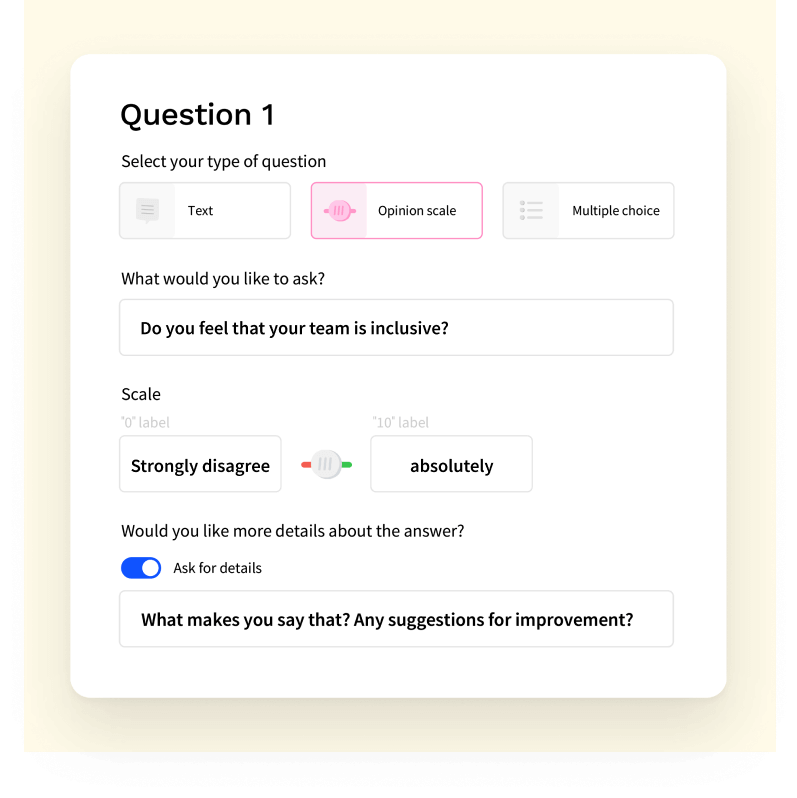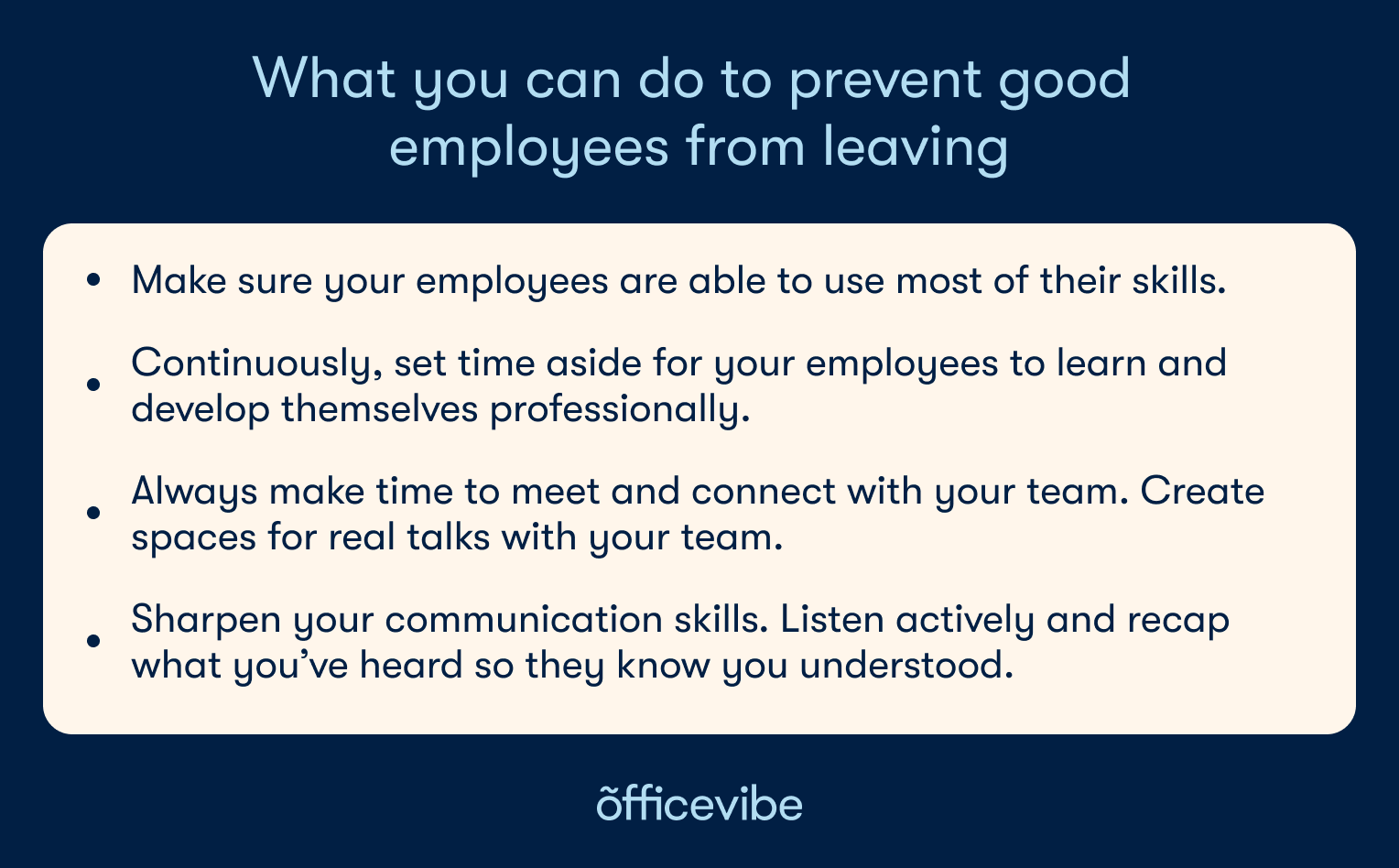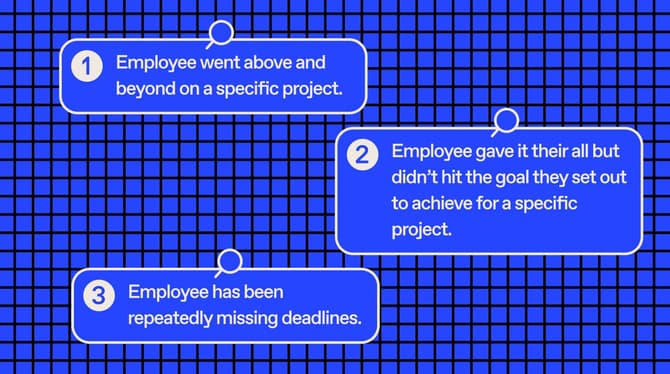Why do good employees leave?
You’ve hired a team of superstars. They’re finally experiencing what you believe to be a good sense of flow.
Everything seems normal, when out of nowhere your employee hands in their resignation. You’re stunned, and not sure where you went wrong managing their retention.
Sounds familiar?
From toxic team cultures to lack of opportunities for growth or distrust in the organization, there are many reasons why a good employee may choose to leave your team.
According to a recent study done by Deloitte, 22% of employees say dissatisfaction with their manager was a top reason to look for a new job.
Talent 2020: Surveying the Talent Paradox from the Employee Perspective
With the right set of tools and a team culture built on trust, collaboration, and communication, you can help employees feel happier at work and reduce the likelihood of them leaving.
Exclusive online summit
·
May 23 2024
Moments that matter: how to seed great work
In this article, you’ll find:
Signs and symptoms: How to spot employees on the run
The good news is, you don’t need to play the role of detective to spot the signs and symptoms of dissatisfied employees. Just look out for these three red flags.
Challenges in adapting to change
When your company goes through any kind of change- whether it is something minor like a new process, or bigger like shifting to remote work, it's important to watch out for good employees who fail to adapt.
When this happens, you may notice more carelessness in their work, higher absenteeism, less engagement than usual in team meetings, or less interest in taking on work they once enjoyed. They may seem annoyed or frustrated with everything.
If you notice changes in behavior in one of your employees, do the following:
- Make time to connect. Whether it's for a Friday team coffee or regular team status update, this will help you notice changes as they happen.
👉 Look out for changes in verbal cues, like how they speak to their colleagues, or non-verbal cues, like a lack of expression on their face. - Gather feedback from your team after any organizational change. Find out how they’re coping. You can do that using Officevibe to create an anonymous custom survey.
👉 Ask questions specific to your situation, like “Our team just merged with the accounts team. Is there anything you’re concerned about?”
Let your team answer on a sliding scale, or in text-based feedback, you can then respond to.

Use Officevibe to build your own custom survey and learn more about how your team is feeling!
Lack of interest discussing career goals:
If there’s one thing we know for sure, it's that engaged employees will regularly be looking for ways to build their careers and advance within your organization.
Think about a recent career conversation with a given employee.
How did it go? Did they ask questions about opportunities, or are they demonstrating general apathy about their growth?
If you’re noticing a lack of interest in discussing their career with you, it might be because they’re in the process of checking out. Remember, the best conversations make the best work happen!
If you think this is happening, it’s time to develop your manager's empathy muscle. Do you understand the challenges your employee faces in their day-to-day? Your employee may be feeling apathetic because of a lack of - or too many - challenges in their role.
By getting to know what these challenges are, you can start to remove some barriers in the way of motivation.
Doing the bare minimum
They used to love taking on new projects, pitching new ideas, and taking on stretch projects. But your once-superstar is now doing the bare minimum! What’s happening?
If you notice your employee happily coasting rather than reaching like they used to, try bringing it up in a 1-on-1 with them.
1-on-1s, like those in Officevibe, give you the time to connect. Try saying things like:
“I’ve noticed you’ve been less interested in taking on projects you used to enjoy. I just wanted to check in and see how you’re doing”.
What you can do to prevent good employees from leaving
The best way to prevent people from leaving is to create a culture on your team that is so good, it makes it hard for them to say goodbye. We’ve got some action-packed tips to help you create a culture fueled by trust, safety, and open communication.
Make sure every team member’s skills are being used
“I keep an Excel sheet of all the projects my team is working on and make sure that the work is equally distributed across my employees and that those projects match their personal growth interests”
Shane, People Manager
Shane says that on his team, the most engaged employees are the ones who feel like they are being stretched in new directions while working on projects that excite and motivate them, based on their skill set.
According to the Deloitte study mentioned above, 42% of respondents who have been seeking new employment believe their job does not make good use of their skills and abilities.
To make sure your employees are consistently developing their skills:
- Set time aside each week for your employees to learn, whether it be for a formal lunch-and-learn, or independent learning through online courses.
- Practice mentorship and coaching whenever possible. When your employees have a problem, rather than solving it for them, coach them on how they can solve it themselves.
👉 Ask questions like, “What have you already tried?” or “What would you do if all your roadblocks were removed?” This will help them with their development.
Always leave time to meet and connect
“If you don’t leave space for connecting with your team, you might be the last one to know if a crisis is happening and by the time you realize, you may have already lost your top performer.”
Alina, Engineering Manager
Alina explains that no matter how busy work gets, she always listens to new ideas and keeps her virtual office door open for meetings.
While you may feel the pinch for time when thinking about scheduling 1-on-1s or virtual team meetings, the time it takes to recruit and onboard someone new will be much greater, so don’t wait until it hurts. Make sure team meetings are an integrated part of your team culture.
To make sure you’re always focusing on connection:
- Create space for real talk with your team. This will give your employees the opportunity to raise any important points to you.
👉A tool like Officevibe's employee engagement platform provides that opportunity through anonymous feedback, shared 1-on-1 agendas, and engagement reports you can share and discuss with your team.
These tools are designed to make employees feel heard and understood. - Hold space for quality conversations with your employees, beyond just status updates. Use our one on one meeting guide to help draw inspiration on how to do this in your 1-on-1s.
Sharpen your communication skills
“Whenever I send an important message to my team, I first read it out loud and ask myself, how might this message be received by my team? Are there assumptions in my head that aren't being explicitly put into words?”
Ariane, Team Lead
Any manager, newly-minted or seasoned, can benefit from developing their communication skills.
Feeling like your manager is not communicating their expectations or that important information is being held back can be such a frustrating experience as an employee.
Sadly, it can lead them to look for work elsewhere.
According to Deloitte,
“66% percent of those who plan to leave their job feel that communications have been ineffective.”
Flex your communication muscles by:
- Being inclusive with your language. Say what you need in the simplest, most direct way possible.
- Repeating important information more than once and through different channels - think Slack, email, and verbally in a team meeting. It takes communicating a message 7 times for someone to start processing the message.
- Listen actively and recap what you’ve heard so they know you understood. Respond to their concerns with phrases like “I understand what you’re saying” or “that must be challenging for you”.
- Measure how your team feels about your communication using Officevibe’s employee pulse survey tool.
What you should do if they leave
As a manager, you should always be thinking about contingency plans.
For example, if your top performer were to leave tomorrow, what plan would be in place to manage the work that only they know how to do?
What would the impact of their departure look like? Who could replace them? This is where succession planning as a manager comes in handy.
If you’ve not yet done this activity for your team, now is a great time to start!
To keep your team calm in light of a colleague’s departure, make sure to:
- Speak to your team directly: Schedule a meeting right away with your team to let them know that you are there to support them through the transition.
They may feel nervous, or worse, inspired by their colleague’s decision to leave. Make sure you’re connecting with them to get a pulse on what they’re feeling and to answer any questions they might have.
👉 Be very clear about the next steps and how you’ll help manage the impact of the departure. Give visibility on how you’ll help reprioritize work, when recruitment will start, and what the plan forward is. - Find out why: If possible, schedule a 1-on-1 with this employee and ask questions about why they’re leaving.
They may or may not feel comfortable sharing, but any feedback or insights you can get can be used to help you move forward as a manager.
No matter how great a manager you are or how wonderful your team culture might be, you can’t stop everyone from leaving.
Celebrate their success, and make sure you acknowledge the impact and contributions they have made to the team.
At the end of the day, wish your employee well and send them off on a positive note as you never know when your paths will cross again!
Too busy? We got you
You can save the image below (drag to your desktop or right-click and save) with the main and most actionable points from this article, and/or send them to your email.

Equip HR and managers with tools to engage, recognize, and drive performance.




